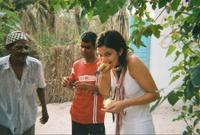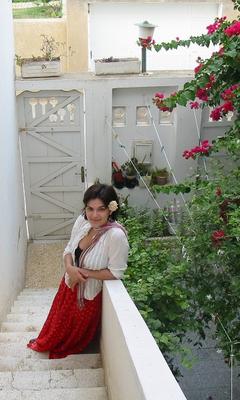Part II: The Garden of Eden
Somehow my image of an oasis is like a pond glimmering in the desert, surrounded by palm trees, waiting to be discovered by lost travelers. I think this came from Saturday morning cartoons as a kid.
There are a couple things wrong with this image. First, desert oases are not sitting around waiting to be discovered... if there's water somewhere in the middle of the desert, chances are the place has been inhabited by civilization for hundreds of years, if not thousands.
Second, the water is not sitting on the surface glittering in the sun. If there was surface water, it would be evaporated in two minutes flat. Rather, a place is considered an oasis if there is enough water beneath the surface of the land to support green vegetation (in contrast to the completely brown land around it.)
The oasis of Touzer has been around for a long time, a stopping point on desert trade routes as well as a flourishing city (however small) in its own right. And if you're there, you should definitely get a guided tour of some oasis gardens.
These are irrigated areas, marked off from the dry land around them with waist-high fences weaved from palm fronds, which serve both to mark property divisions within the garden, and to keep the sand from blowing into the garden and burying everything carefully nurtured there.
 We met a guy who knew a guy with a car who agreed to drive us around the more touristy garden area of Touzer. (There are also horse-drawn carts that travel the path if you can get yourself to the entrance.) Inside, we visited a garden plot which is open to tourists.
We met a guy who knew a guy with a car who agreed to drive us around the more touristy garden area of Touzer. (There are also horse-drawn carts that travel the path if you can get yourself to the entrance.) Inside, we visited a garden plot which is open to tourists.
 The highest level is palm trees, which provide shade for the rest of the garden (and dates, harvested in the fall.) It's like a supermarket of greenery. You can walk around and pluck grapes from the vine, figs, pomegranates, and dates from the trees, at the lower level you can see roses, hot peppers, mint, and other herbs all thriving there.
The highest level is palm trees, which provide shade for the rest of the garden (and dates, harvested in the fall.) It's like a supermarket of greenery. You can walk around and pluck grapes from the vine, figs, pomegranates, and dates from the trees, at the lower level you can see roses, hot peppers, mint, and other herbs all thriving there.
It seems miraculous that such a lush setting should exist so close to the (by comparison) wasteland of the desert, and my appreciation for the story of Adam and Eve has been completely changed. Now I see what it really means to the cultures receiving this story to imagine banishment from a beautiful garden to the hostile lands around it, the harsh life that follows the transgression and the comparison to the easy bliss of inhabiting a oasis garden built for two.
...Totally lost on a kid used to green suburban lawns.
And, I think, on most of the great artists of the European tradition, who had never seen deserts. I think what is truly salient is the Garden of Eden imagery is the contrast between the ease of life in paradise being cared for by God, to having to toil, struggle and suffer in the bitter desert. But I have yet to find a painting of this scene that captures the quality of paradise as a place of cool shade and easy food.
Here's Michelangelo's from the Sistine Chapel...

There are a couple things wrong with this image. First, desert oases are not sitting around waiting to be discovered... if there's water somewhere in the middle of the desert, chances are the place has been inhabited by civilization for hundreds of years, if not thousands.
Second, the water is not sitting on the surface glittering in the sun. If there was surface water, it would be evaporated in two minutes flat. Rather, a place is considered an oasis if there is enough water beneath the surface of the land to support green vegetation (in contrast to the completely brown land around it.)
The oasis of Touzer has been around for a long time, a stopping point on desert trade routes as well as a flourishing city (however small) in its own right. And if you're there, you should definitely get a guided tour of some oasis gardens.
These are irrigated areas, marked off from the dry land around them with waist-high fences weaved from palm fronds, which serve both to mark property divisions within the garden, and to keep the sand from blowing into the garden and burying everything carefully nurtured there.
 We met a guy who knew a guy with a car who agreed to drive us around the more touristy garden area of Touzer. (There are also horse-drawn carts that travel the path if you can get yourself to the entrance.) Inside, we visited a garden plot which is open to tourists.
We met a guy who knew a guy with a car who agreed to drive us around the more touristy garden area of Touzer. (There are also horse-drawn carts that travel the path if you can get yourself to the entrance.) Inside, we visited a garden plot which is open to tourists. The highest level is palm trees, which provide shade for the rest of the garden (and dates, harvested in the fall.) It's like a supermarket of greenery. You can walk around and pluck grapes from the vine, figs, pomegranates, and dates from the trees, at the lower level you can see roses, hot peppers, mint, and other herbs all thriving there.
The highest level is palm trees, which provide shade for the rest of the garden (and dates, harvested in the fall.) It's like a supermarket of greenery. You can walk around and pluck grapes from the vine, figs, pomegranates, and dates from the trees, at the lower level you can see roses, hot peppers, mint, and other herbs all thriving there. It seems miraculous that such a lush setting should exist so close to the (by comparison) wasteland of the desert, and my appreciation for the story of Adam and Eve has been completely changed. Now I see what it really means to the cultures receiving this story to imagine banishment from a beautiful garden to the hostile lands around it, the harsh life that follows the transgression and the comparison to the easy bliss of inhabiting a oasis garden built for two.
...Totally lost on a kid used to green suburban lawns.
And, I think, on most of the great artists of the European tradition, who had never seen deserts. I think what is truly salient is the Garden of Eden imagery is the contrast between the ease of life in paradise being cared for by God, to having to toil, struggle and suffer in the bitter desert. But I have yet to find a painting of this scene that captures the quality of paradise as a place of cool shade and easy food.
Here's Michelangelo's from the Sistine Chapel...



0 Comments:
Post a Comment
<< Home